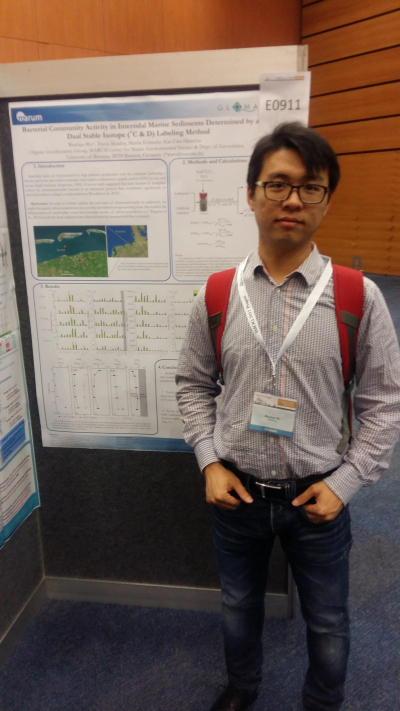Die Inhalte dieser Seite sind leider nicht auf Deutsch verfügbar.
Seitenpfad:
Weichao Wu
Report of GLOMAR PhD student Weichao Wu about his participation in the International Meeting on Organic Geochemistry (IMOG) 2015 in Prague, Czech Republic from 13 – 18 September 2015
With the support of GLOMAR, I participated the 27th international meeting on organic geochemistry in Prague, Czech Republic. This meeting has attracted more than 400 organic geochemists all over the world presenting more than 80 oral and 400 poster presentations mainly covering petroleum geochemistry to biogeochemistry during 5 days program.
During this conference, I presented my latest work “Bacterial community activity in intertidal marine sediments determined by a dual stable isotope (13C & 2H) labeling method” as a poster in the session Benthic Process. My work investigated the assimilation of inorganic carbon fixation by the bacterial community in the intertidal sediments using recently developed dual isotope labeling method. This method could be used to estimate the microbial activity, lipid production and carbon metabolism. My work suggested that this inorganic carbon fixation was most likely attributable to anapleurotic reaction of heterotrophic bacteria rather than chemoautotrophy. Afterwards, my poster has gained some attention from other biogeochemists, which gave me an opportunity to discuss more about the experiment methods and techniques details with them. What’s more important, I have learned a lot about biological inorganic and organic carbon fixation mechanisms, which gave me more ideas for the further work.
In this meeting, I was impressed by plenary oral presentation “Hydrogen Isotopes in Amino Acids: more than just precipitation tracers” by Marilyn Fogel from United States and “Biological investigations into the genetic underpinnings of hydrogen isotope fractionation in plants and microbes” by Dr. Alexander Bradley from United States because their work about hydrogen isotope not only addressed some possible mechanism controlling hydrogen isotope fractionation, but also was helpful to solve some problems in my current work about hydrogen isotope labeling incubation experiment. During the coffee break, we also had a discussion about hydrogen isotope as well as my personal data, which was very helpful to my project.
In conclusion, I have learned a lot after joining this meeting. Kindly, I would like to thank GLOMAR for granting me to join this international meeting, which will bring me an unforgettable memory.
During this conference, I presented my latest work “Bacterial community activity in intertidal marine sediments determined by a dual stable isotope (13C & 2H) labeling method” as a poster in the session Benthic Process. My work investigated the assimilation of inorganic carbon fixation by the bacterial community in the intertidal sediments using recently developed dual isotope labeling method. This method could be used to estimate the microbial activity, lipid production and carbon metabolism. My work suggested that this inorganic carbon fixation was most likely attributable to anapleurotic reaction of heterotrophic bacteria rather than chemoautotrophy. Afterwards, my poster has gained some attention from other biogeochemists, which gave me an opportunity to discuss more about the experiment methods and techniques details with them. What’s more important, I have learned a lot about biological inorganic and organic carbon fixation mechanisms, which gave me more ideas for the further work.
In this meeting, I was impressed by plenary oral presentation “Hydrogen Isotopes in Amino Acids: more than just precipitation tracers” by Marilyn Fogel from United States and “Biological investigations into the genetic underpinnings of hydrogen isotope fractionation in plants and microbes” by Dr. Alexander Bradley from United States because their work about hydrogen isotope not only addressed some possible mechanism controlling hydrogen isotope fractionation, but also was helpful to solve some problems in my current work about hydrogen isotope labeling incubation experiment. During the coffee break, we also had a discussion about hydrogen isotope as well as my personal data, which was very helpful to my project.
In conclusion, I have learned a lot after joining this meeting. Kindly, I would like to thank GLOMAR for granting me to join this international meeting, which will bring me an unforgettable memory.



